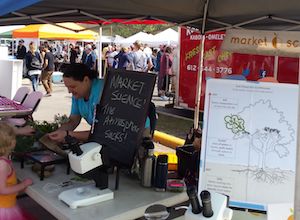Beth Fallon receives University’s Outstanding Community Service Award for work with Market Science.

On Saturday mornings, visitors to Twin Cities farmers market expect to find local produce, flowers and perhaps a baked good or two while strolling by booths and talking to vendors. But Beth Fallon and fellow volunteers with Market Science have brought a whole new product to the market: science education.
An outreach program based at farmer’s markets in the Twin Cities, Market Science brings scientists into the community. These volunteers set up hands-on learning activities for kids, answer questions and engage in conversations with market goers. Fallon, a graduate student in the Plant Biological Sciences graduate program in the College of Biological Sciences, who helps lead the initiative, recently received the University of Minnesota’s Outstanding Community Service Award in recognition of her work with Market Science.

The Outstanding Community Service Award recognizes faculty, students and staff at the University for their efforts in contributing to the well-being of the broader community. Jeannine Cavender-Bares, Fallon’s faculty advisor, sees the direct impact Fallon made in this area over the past few years.
“Over the past three years, through the Market Science program, she has spent countless hours developing approaches to sharing science with members of the public — people who in the daily course of their lives have very little exposure to science,” says Cavender-Bares.
For Fallon, she sees the market as a unique space where scientists and the broader community can connect. Whether it’s leading a demonstration on butterflies and pollinators or using seed art to engage in a discussion about types of grains, she sees this as a great place to interact with those in the Twin Cities.
“Farmer’s markets draw from across demographics and give scientists an opportunity to engage with the community and learn how their science affects others,” says Fallon.
In particular, one interaction stuck out during a day they hosted a session on counting tree rings. A community member who stopped by the booth talked about how she remembered counting tree rings with her family of the trees they planted growing up. This brief interaction sparked a moment of realization in science outreach for Fallon.
“Connecting to personal history is very important in reaching out to people,” she says. “It’s hard to talk about why something’s important to the broader public if you don’t know what’s important to your neighbors.” – Lance Janssen
Market Science returns to Midtown Farmer’s Market May 13. Check marketsci.org for upcoming dates, locations and topics.